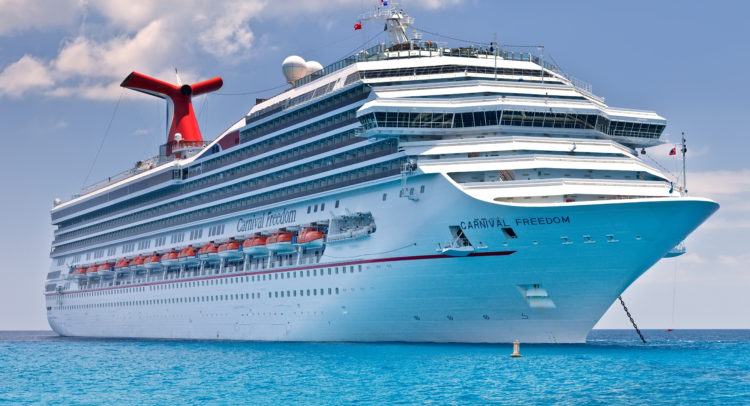The relaxing of COVID-19 guidelines for the cruise industry should have been a cause for celebration. Some cruise lines have even recovered because of the news. The news isn’t bright enough to make Carnival Cruise Lines (CCL) shine, however. The stock is currently down 11% because it announced a $1 billion equity raise, leaving investors skittish.
When Carnival revealed that the billion dollars would be used for “general corporate purposes,” that made a bad situation even worse. Some cruise lines are doing better than others. Yet, there’s a certain amount of risk to all of them. The equity raise leaves me bearish on Carnival.
The last 12 months for Carnival have already been downhill. This latest move only accelerates the decline. A year ago at this time, Carnival started a run-up that, by late September, let the company break the $25 per share mark. Today, it’s down under $10 per share.
Wall Street’s Take on CCL Stock
Turning to Wall Street, Carnival has a Hold consensus rating. That’s based on four Buys, five Holds, and four Sells assigned in the past three months. The average Carnival price target of $13.78 implies 40% upside potential.
Analyst price targets range from a low of $7 per share to a high of $29 per share.

Investor Sentiment is Shockingly Upbeat
The latest move from Carnival is scaring off some investors. That’s clear, based on the extent of today’s plunge. However, three out of four major metrics of investor sentiment are still positive. Right now, Carnival has a 5 out of 10 Smart Score on TipRanks, giving it a neutral rating. This implies that the stock has equal chances of outperforming or lagging the broader market.
Hedge fund involvement, based on the results of the TipRanks 13-F Tracker, is one positive indicator. Hedge funds collectively bolstered their involvement by 1.5 million shares last quarter. This came after a decline in the previous quarter that saw hedge funds sell close to two million shares.

Meanwhile, insider trading at Carnival is also showing positive signs. Insiders purchased $2.4 million in shares in the last three months. That’s actually building on a past string of purchases over the full year. Buy transactions have outstripped Sell transactions at Carnival over the last 12 months by a figure of 31 Buys to 23 Sells.
Moreover, based on SEC reports, no insider has sold a share of Carnival since January 2022. It’s as though insiders are expecting big potential upside coming up; why would they hang on to shares about to plunge even further?
Retail investors also seem encouraged, though at declining rates. The number of portfolios on TipRanks holding CCL shares has increased less than 0.1% in the last seven days. However, this number increased by 2.2% in the last 30 days. The latest news may change that, though.
Finally, there’s the matter of Carnival’s dividend history. Carnival suspended dividends back in February 2020, just ahead of the pandemic shutting down operations. There are no indications of when dividends will restart, but they may not be far off now that cruise lines are more able to operate.
An Economic Iceberg Right Ahead
Investor sentiment may be positive by some measures, but it’s hardly universal. In fact, it will likely be interesting to see the impact of the latest plan to deliberately dilute the stock by releasing $1 billion worth into the market. Given current prices, that’s close to 100 million shares thrown into the pool.
Certainly, Carnival could use some extra cash. Back in May, the company sold $1 billion in bonds in a bid to pull in more cash. That’s not all, either; in July 2021, Carnival set up a $2.4 billion bond sale designed to buy back some earlier debt issues. Then, October of 2021 saw another $1.5 billion junk bond sale that was later increased to $2 billion.
If it seems like Carnival’s been taking on a lot of debt lately, there’s a good reason why – because it has. Taking just the numbers we have so far, Carnival issued over $5 billion in bond debt in the last year. Now, it plans to dilute the share value of its already-crippled stock by another billion dollars.
Like the old and very cynical adage says about government spending: “A billion here, a billion there, and pretty soon, you’re talking about real money.”
However, the stock sale could prove helpful. Reports suggest that some of those “general corporate purposes” may include “addressing 2023 debt maturities.”
If Carnival is raising cash via stock sales to get itself at least somewhat out of hock, that’s not necessarily a bad thing. It’s not good up front—it waters down the stock value by making it a lot more available—but it could help the company’s operations down the line.
Yet, there’s a much bigger problem afoot. Yes, the Centers for Disease Control and Prevention is finally getting its boot off the collective throat of the entire cruise industry by ending its COVID-19 program for cruise ships. It’s also no longer reporting caseloads on cruise ships, which it promptly rebroadcast to the public and likely made every ticket holder promptly reconsider.
Even as this albatross is taken off cruise lines’ collective neck, another—potentially larger— problem has replaced it: a recession. Along with its buddy, inflation, prices for everything are skyrocketing, and that’s going to make the market for cruises inherently weaker. Customers’ expanding bills at the grocery store and the gas pump will make a cruise seem like a forlorn hope.
Sure, some pent-up demand will likely express itself, but that will lessen as time goes on. Customers who longed for a return to the open sea may well do so just one last time before pulling their wallets back into their pockets and bracing for the impact a recession will bring along with it.
Concluding Views – CCL’s Low Stock Price is Justified
Laden with debt, stock dilution, and sailing into extremely unfriendly economic waters, that’s the basic sum-up for Carnival Cruise Lines right now. It’s pretty much every reason I need to be bearish.
Yes, the company is trading close to its lows right now, both its 52-week lows and its lowest price targets. Still, I’m not looking for positive developments to take place any time soon, despite positive investor sentiment.
There’s likely still a bit more room for the company to drop. So, get ready to go salvaging later on, after the next potential bankruptcy in the making.



















